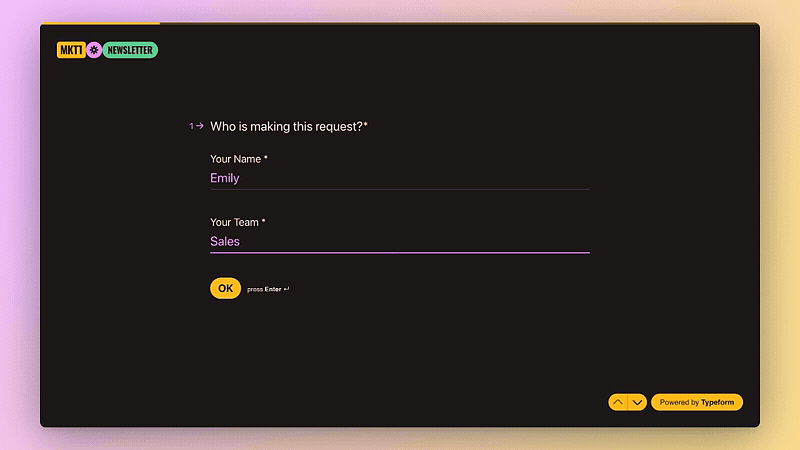🎙️ This free edition of MKT1 newsletter covers Season 1, Episode 1 of “Dear Marketers with Emily Kramer & Friends” podcast.
Included in this newsletter:
Why I created Dear Marketers podcast & what to expect
Audio & video version of the podcast
Newsletter article breaking down how to handle marketing requests from other teams, with MKT1 frameworks and podcast highlights
Dear Marketers,
I bought myself a fancy microphone and a massive ring light, brought on the best producers I know (Caspian Studios), and boom I’m now a podcast host.
Besides making a few Amazon purchases, here’s how this podcast came about:
I get tons of thoughtful B2B startup marketing questions from my advisees, followers on LinkedIn, and marketers I meet around town. And whenever I don’t have an answer to one of these questions or just want a second opinion, I call a short-list of marketing friends I have on speed dial. I thought it would be fun (and informative) if you could eavesdrop on these conversations. And selfishly, I wanted an excuse to get to chat with them more often.
From this, Dear Marketers was born—think of it as an advice column in podcast form.
Here’s what to expect from each podcast episode:
This podcast is not your typical interview-style format. We kick off each episode with a community-submitted question, like “How do you hire great marketers?”, “Is the company blog dead?” and “Should you make your founder an influencer?”
We’ll pack our answers with candid advice, strategies you can apply right away, and proven MKT1 frameworks. My co-hosts, Grace Erickson, Jenny Thai, and Devon Watts, will be around all season long to answer your questions. They are in-house marketing leaders at Cocoon, Vanta, and Mercury, respectively–and each brings a different core skillset to the table, plus a ton of marketing breadth. Combined we have 75+ years of marketing experience!
I’ve gotten to know my three co-hosts over the last decade, starting when were all part of the OG Asana marketing team, and later when I worked with Devon and Grace at Carta. And they are my real life friends too. Why does this matter to you? Well, these conversations skip the formalities. Each podcast episode is like having a marketing-focused dinner conversation with us.
Expect some surprise guests and fun too. We’ll “phone a friend” when needed (is it lame to make a “Who Wants to be a Millionaire” reference in 2025?). We’ll sign off each episode with a game, appropriately called “Best, Marketer”. In the first episode, I let Jenny & Grace roast me during this segment, which must have been super cathartic to do on a podcast with your former boss.
Want to ask a question in a future episode? We have a Typeform for that.
If you like what you hear or watch, rate us, give us a thumbs up, share us and/or subscribe wherever you get your podcasts—or even places where you don’t usually get your podcasts. Launching a brand new, 12 episode podcast is a bit scary, and we’d appreciate all the love we can get.
Each episode also comes with a detailed newsletter (like this one!) that brings together frameworks and advice from past MKT1 Newsletters.
Spotify | YouTube | Apple Podcasts
Thanks to our first ever Dear Marketers sponsors:
I vet each partner personally. These are genuine recommendations (even though yes, I do get paid for this).
Typeform: Thanks to our season-long presenting sponsor. Create delightful branded forms for collecting leads, feedback, and research. We even use a branded Typeform to get questions for each episode of Dear Marketers.
🎁 Offer: Use code MKT1 to get 20% off their annual growth plan.
Attio: The next generation CRM with built-in AI agents and powerful workflows. We use Attio to manage partnerships and sponsors and to track marketing leader relationships at MKT1.
🎁Offer: MKT1 subscribers get 15% off your first year.
Ahrefs: All-in-one marketing intelligence. Use ahrefs to audit and optimize your website, study competitors’ websites, track your web mentions and links, and monitor your rankings in search engines.
How to handle requests from other teams
Each Dear Marketers episode comes with a companion post (like the one below). It’s not just a recap or transcript, it expands on the episode with key takeaways, MKT1 frameworks, and extra insights. Read it before, during, or after the pod—we hope it makes each episode even more useful and actionable.
“Dear marketers, I’m Sandy, Head of Marketing at Pocus. We’re an AI sales platform that turns every B2B sales rep into a top performer, and I would say our team is pretty good about not throwing a ton of requests at us. But we do get a lot of requests, and we can’t do them all. So my question is: What’s the best way to prioritize requests from other teams? How do I make sure that I’m taking all of their advice and their suggestions into my plans without derailing them?”
Episode 1: Question submitted by Sandy Mangat
We selected this question first because every marketer has been in this situation: Your Slack is overflowing with requests from sales, product, customer success, and your CEO. Some are reasonable. Some are absurd (see below on Oprah). But all of them can quickly derail your carefully planned roadmap. If you want to commiserate on absurd requests, here’s a long list on LinkedIn.
As I always say, the #1 priority of marketing is to drive impact and avoid random acts of marketing. To do that, you need to get a handle on your requests. Here are our recommendations:
✔️ Find the real request behind the request
✔️ Set and share clear goals (and non-goals!)
✔️ Build a request intake process
1. Get to the “why”: Understand the “request behind the request”
“Usually, when you start asking why, you get to the actual problem that needs to be solved—and sometimes, you realize you don’t even need to fulfill the original request.” - Jenny Thai in Episode 1
When co-workers are requesting a lot from marketing, it’s often because they feel their own stressors and think marketing can help. Think about what other teams and co-workers care about to gain a better understanding of their request, the urgency, and what they might actually need. I also find taking this approach makes a lot of the urgent (and sometimes ridiculous requests) seem more manageable and not as frustrating.
And as marketers, you should be good at understanding your customers: what motivates them, what their main challenges are, etc. Apply the same thinking to understanding other teams—they are in fact one of your customers. I wrote more about this in my internal marketing newsletter last year.
Here’s a breakdown of how I think about other teams’ motivations. I’m well aware that this is a simplification and you’ll have to modify this to fit your company and co-workers:
“A request from your CEO is always going to be treated differently than one from an SDR. And pretending that isn’t true sets everyone up for failure.” - Grace Erickson
Not all requests carry equal weight. The reality is that some requests will and should always get prioritized over others. And sometimes you just have to knock out a few requests from your CEO, even if it’s not the highest priority on your list. And for every team and person at your company, remember it’s a bit of give and take.
Checklist - What to do when you get a request:
✅ Don’t take the request at face value.
✅ Consider why behind it: Dig deeper to understand the actual problem the requester is trying to solve
✅ Consider who the requester is
✅ Consider how the request may impact your goals and key revenue levers (top-of-funnel growth, conversion, expansion, etc.)
✅ Consider if it should take priority over other things on your plate
2. Set goals proactively to minimize ad hoc requests
“I think the best defense against requests is your goals. It’s the only way you can actually make the right decisions and [understand] the why” - Emily Kramer in Episode 1
If you don’t set and share clear marketing goals, people will fill that vacuum with their own priorities. They’ll feel like marketing isn’t doing the right things because they don’t know what you are actually doing. Everyone is in some ways a marketer, so they’ll start throwing ideas at you.
The point is not to avoid ideas and suggestions from other teams, but to get requests at the right time and be able to prioritize effectively. Meaning, you want the request when planning the launch, not the night before.
I wrote extensively about annual planning, prioritizing, and establishing a strong operating cadence for your marketing team over the last couple of months. The short of it is, you need to make a marketing decision dashboard that summarizes your strategy. Here’s how:
Establish your marketing strategy and revisit it a few times a year.
I recommend bringing in leaders from other teams for some of these discussions too, so they can contribute to thinking and get aligned.
Then codify this in a marketing decision dashboard, which serves as a rubric for evaluating requests and a single source of truth for making marketing decisions.
Using this dashboard really helps you make sure that every request, campaign, and initiative is aligned with broader business objectives. It also makes it easier to say no to random, low-priority requests.
Share the dashboard. You can even add a link to it in your marketing request intake form.
Here’s what to include in a marketing decision dashboard:
This template is available at the bottom of this newsletter for paid subscribers in Google Slides.
Marketing advantages:
What are the unique strengths of your company that can be used to accelerate growth? (E.g. Potential for network effects, excess customer-love, a clear wedge or vertical focus) My list of 12 most common advantages here.ICP priorities:
Who are the primary, secondary, and tertiary target customers? What’s the stack ranked, priority order of these ICPs?Key storylines & messaging priorities:
What are the most important narratives and themes marketing is driving right now? I summarize these by writing “Perceptions,” which are your main narratives from the perspective of what you want your prospects and customers to say or think.Revenue levers & funnel focus:
Figure out the best path for driving revenue growth today. There are only 4 main ways all B2B companies drive revenue–stack rank these too.Grow top of funnel in same market or segment (aka capture more of the pie)
Grow top of funnel in new market or segment (aka expand the size of the pie)
Improve efficiency throughout the funnel (by increasing conversion rates, reducing time to close, lowering CAC)
Increase revenue per customer (through expansion & upsell or increasing new customer contract value)
More on revenue levers in this vintage MKT1 Newsletter
When marketing has an opportunity to do a company-wide presentation, at an all-hands, company kick-off, offsite, etc, use the time share your strategy and the thought behind your marketing decision dashboard. You can also use this time to show the behind-the-scenes of marketing workflows. Walk through the process of making case studies or planning a campaign. Giving insight into this will help the company understand what really goes into your marketing efforts.
Set & share goals, and non-goals too
Based on your marketing decision dashboard, set goals for the year, half year, quarter and/or month. The right time horizon will depend on your company’s stage and way of operating. During the planning process, invite leaders from other teams to contribute (just like you should do for those strategy conversations). And then again, when kicking off specific projects, loop in the right stakeholders.
“At early-stage companies, you don’t always have the luxury of a really long time horizon. If your company can’t see nine months ahead, don’t force yourself into a long-term plan. Instead, set near-term priorities and adjust as needed. Otherwise, you might just be creating misalignment where misalignment doesn’t need to exist because you don’t actually know what you’re going to need to do three quarters from now. So why spend time debating it?”
-Grace Erickson
No matter the time horizon, set clear, measurable goals and share those out. For more on what, how, and when to share, my newsletter from January on running your marketing team will help: How to run your marketing team day-to-day.
Also set non-goals, this is an amazing way to preemptively address misaligned requests. When setting this, indicate why it’s a non-goal. Just reference that beautiful marketing decision dashboard you just made.
Non-goals are my favorite. I love setting non-goals—way more fun to set than goals. It’s just, ‘Here’s what we’re not doing this quarter and why.’ It really lets people know, ‘Hey, I heard you. I took it in. I thought about it…And it’s still a no.’ -Emily Kramer in Episode 1
3: How to (tactically) manage the request process
"I think you need to strike the balance of getting the information you need to actually assess the request and figure out if it makes sense to act on—versus making it so onerous that people are too scared to even fill it out." - Jenny Thai in Episode 1
While you should include stakeholders from other teams in strategy, planning, and product kickoff meetings, there will always be requests that come up day-to-day. Creating a structured intake process for this will reduce the chaos and prevent marketing from becoming a reactive service organization for every one-off request.
Make a simple (but not too simple) form to fill out. Create a little bit of friction so requesters have to put thought into the process but don’t make it a terrible experience (like canceling Xfinity–just did that a literally few mins ago and haven’t been more annoyed in a while). A branded Typeform (like this example) adds some pizzaz and style to the form and you can connect it to your project management tool of choice (and Slack too) so you can prioritize everything and report back on status.
Here’s what you should definitely include:
Requester: Name & team
Description of request
Why they are making this request and the problem they are facing
Relevant-goal: Include a pre-made drop down of marketing goals. This is optional, but is a great way to reiterate your goals and how marketing prioritizes.
Relevant timelines for the request. And I wouldn’t ask for “priority,” it invites people to say “high” for everything.
Actually review and prioritize these requests
Nobody likes it when they spend time making a request and it falls into an abyss of marketing tasks that will never get done.
Have an actual cadence for reviewing and prioritizing, make that obvious in your form, and have a running list of these requests–recurring meetings or Asana tasks are super helpful here.
I like to have these requests flow right into Asana and prioritize them weekly.
I’ll then tag the requester in a comment in Asana so they know why we prioritize and when/if we’ll get to it.
You can also have those comments run straight into a Slack message to that person.
More on prioritization, including a walkthrough of how I do this in Asana in this newsletter.
Takeaways
“I think the point here is that under stress, even the greatest of humans with the best of intentions still make ridiculous, absurd requests. Just because someone makes a bad request doesn’t mean they’re horrible. It just means their request is.” -Emily Kramer (sort of joking) in Episode 1
If you’re getting barraged with marketing requests, help your co-workers, help you. Understand where they are coming from. Share goals with them. Give them a beautiful request form to fill out. And keep them updated on what you’ve prioritized and why.
Next time someone asks you for a last-minute billboard or a “viral” TikTok campaign, you’ll have a structured way to handle it. Unless it’s your CEO asking for something they can’t live without and you said no the last two or three times, then maybe, just maybe go for it!
If you’re still feeling overwhelmed by it all, take a listen to the podcast and commiserate with us while getting some great ideas to solve the problem.
Want to add some fun to your listening experience? See how long it takes you to get Bingo on this Episode 1 card. From billboards, to taco bell, Steph Curry, and saying goals way too many times, we cover it all.
More from MKT1 & Dear Marketers
⭐ Please rate us or subscribe wherever you get your podcasts: Spotify, YouTube, Apple Podcasts
📰 Additional reading from MKT1 Newsletter
✂️ Templates & videos for paid subscribers - Available in our template library for paid subscribers only





















